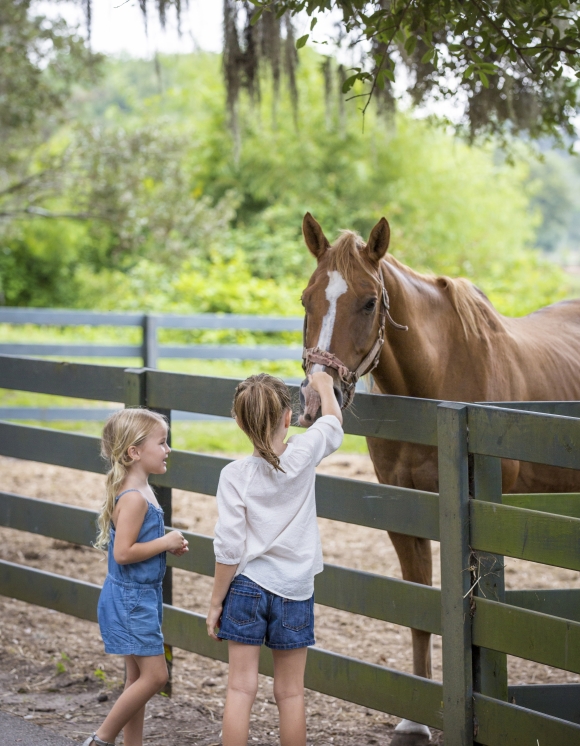Explore the Past
Discover the storied past of Hilton Head Island, including a memorial for Sea Pines founder Charles Fraser and historic ruins that give a glimpse of life in the Lowcountry as far back as 4,000 years ago.
Historical Sites
-
Charles Fraser’s Memorial at the Liberty Oak Tree
-
Sea Pines visionary and founder Charles Fraser created an environmentally friendly community that was among the first of its kind. Today a plaque and bust of Charles Fraser can be found in Harbour Town under the shade of the Liberty Oak tree. While the monument serves as a memorial, Fraser’s true legacy is all around us.
-
Liberty Oak
-
Did you know the Harbour Town Yacht Basin was built around the Liberty Oak? Sea Pines founder Charles Fraser had a passion for protecting the environment and insisted the magnificent tree be spared during the construction of the yacht basin. Despite the significant additional expense, the marina was built around the tree.
Over the years, it has served as the venue for thousands of Gregg Russell concerts, celebratory events from weddings to proposals and even a memorial for Charles Fraser himself. The Liberty Oak is approximately 325 years old, close to 55 feet tall and 90 feet across and estimated to weigh 38 tons.
-
Lighthouse Keeper’s Cottage
-
Constructed in 1880, the charming 19th-century cottages that house the Harbour Town Bakery & Café and Sea Pines Real Estate’s Harbour Town office were once a keeper’s dwelling for Hilton Head Island’s Leamington Lighthouse. During the bakery’s renovation in 2020, the hand-printed name of lighthouse service seaman K.E. Kremser dated 1899 was discovered on a board beneath an interior wall.
Records show Kremser was stationed in various lighthouses in the Charleston and Georgetown area and served on the lighthouse tender Pharos, charged with servicing the Hilton Head Island lighthouse. Both cottages were moved to The Sea Pines Resort in the 1960s and later converted into the present-day Harbour Town Bakery and Sea Pines Real Estate cottage.
-
Shell Ring
-
The Sea Pines Forest Preserve is home to a thriving ecosystem, but it also plays a vital role in preserving Hilton Head Island’s prehistory. Long before the island was a popular vacation destination, Hilton Head served as the hunting and harvesting grounds for ancient Native Americans more than 4,000 years ago. One of the striking shell rings they left behind is nestled within the Forest Preserve for visitors to experience and enjoy. Historians believe it was a communal gathering place or a site where rituals were performed.
-
The Harbour Town Lighthouse
-
Conceived by Sea Pines founder Charles Fraser, the Harbour Town Lighthouse has become the landmark most associated with Hilton Head Island. The symbolic beacon was designed to attract people to Harbour Town, envisioned by Fraser as a fun, lively gathering spot for both the Sea Pines community and the island.
Construction of the 90-foot white-and-red-striped structure began in 1968 but was not completed in time for the first Heritage Classic golf tournament held in 1969. Years later, the interior of the lighthouse was turned into a museum with photographs and memorabilia lining the walls, offering visitors who climb the 114 steps to the top of the tower a colorful history of the island.
-
Cemetery on Oyster Landing Road
-
This small, tucked-away cemetery in Sea Pines is filled with rich history from the Civil War era. Known today as Lawton Cemetery, it was part of the rice-producing Lawton Plantation in the 1830s. Out of its numerous tombstones, one in particular stands out – the grave marker of Thomas Frazier, among the first African American soldiers in American history. A member of one of the 21st U.S. African American troops who served during the Civil War, Frazier’s legacy still lives on. His tombstone survives after more than a century.
-
Old Lawton Rice Field
-
At Old Lawton Rice Field, visitors can view marshes and wildlife from a boardwalk featuring three observation decks. This fascinating piece of history is accessible by walking or biking on the lush, historic trails of the forest preserve. The Boggy Gut boardwalk takes you down a mile of the 1840 rice fields.
-
Lawton Plantation, now home to Six Oaks Cemetery
-
Once sprawling over 1,800 acres, Lawton Plantation has a rich history intertwined with Hilton Head Island. The estate, also known as Calibogue or Lawton’s, was the only plantation on Hilton Head Island to grow rice. Since the plantation’s beginning there have been several owners. The most significant of these were the namesakes, Martha Sarah Stoney Barksdale Lawton and her husband, Joseph Lawton, who inherited the property and left it to their son, Samuel.
Mary, the granddaughter of late descendent Alene Lawton Wyman, went on to marry Charles Fraser, founder of The Sea Pines Resort, which now encompasses the very land her ancestors owned.
-
Stoney Baynard Ruins
-
Once part of a large plantation owned by Captain Jack Stoney, the home was built in the late 1700s out of tabby – a combination of crushed oyster shells, whole oyster shells, water and lime – and is the only tabby mansion built on Hilton Head Island. The plantation was originally named Braddock’s Point for the commander of the sailing ship, Beaufort. In 1845, a portion of the property was bought by William Baynard. During the Civil War, Union troops used it as their headquarters. Although the Baynard family reacquired the property after the war, the house burned in 1869 and was never rebuilt.
Open to the public, the Stoney Baynard ruins include portions of the main house, the chimney footing for what may have been an overseer’s house, and the foundation of a slave house.
-
Braddock Point’s Cemetery
-
One of several Gullah family cemeteries on the island, this small graveyard, also known as Harbour Town cemetery, is the burial grounds for the Chisolm and Williams families, descendants of enslaved West Africans who worked on Braddock’s Point Plantation. Located on Lighthouse Lane in Harbour Town, the cemetery is reputed to contain the graves of slaves, but the oldest surviving headstones date to the Civil War. Following West African tradition, some of the headstones had or have ceramic plates pressed into them to provide the deceased something to eat from in the next world.
-
Legacy Oaks





